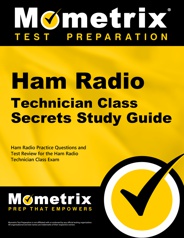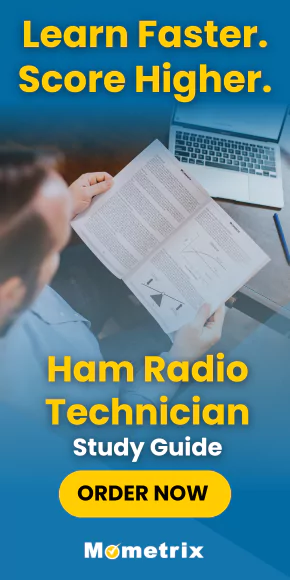The Federal Communications Commission (FCC) provides a Technician Class exam to certify the operation of an amateur station. This page covers the Technician Class radio license needed to operate an amateur radio, also called ham radio. Three levels of ham radio licenses are issued by the FCC, and the technician license is intended for beginners.
Click “Start Test” above to take a free Ham Radio Technician practice test!
Why Get a Ham Radio Technician License?
To operate a ham radio, a person must have a license. Using a ham radio allows you to contact others during natural disasters or emergencies, interrupting internet services.
The technician exam is considered the entry-level license exam. Still, with that entry-level license, you can broadcast on VHF and UHF amateur bands. The license allows you to broadcast on Amateur Radio frequencies above 30 megahertz. You will also have the right to broadcast over a limited number of HF or “shortwave” bands. These are regulated to the 80, 40, and 15-meter bands for individuals using CW.
Exam Eligibility
Meeting the eligibility requirements for this exam is relatively easy. To take the test, you must have the following:
- A valid United States mailing address
- Proof of identity
- A social security number or another approved taxpayer identification number
- An FCC registration number will be accepted if you do not have your social security number or other taxpayer identification number
Ham Radio Technician Outline
The Ham Radio Technician Exam contains 35 multiple-choice questions, and the questions are split into ten main categories.
1. Commission’s Rules (6 questions)
The six questions in this category are pulled from a pool of 67 questions. The pool is split into six groups:
Group A
- Purpose and permissible use of the Amateur Radio Service
- Meanings of basic terms used in the FCC rules
- Phonetics
- RACES Rules
- Operator/primary station license grant
- Interference
- Frequency coordinator
Group B
- Power output
- Emission modes
- Spectrum sharing
- Frequency allocations
- Transmissions near band edges
- Contacting the International Space Station
Group C
- Licensing
- Sequential and vanity call sign systems
- Name and address on FCC license database
- Places where the Amateur Radio Service is regulated by the FCC
- Term
- Renewal
- Grace period
- Maintaining mailing address
- International communications
Group D
- Authorized and prohibited transmissions
- Communications with other countries
- Music
- Exchange of information with other services
- One-way transmission
- Encryption
- Indecent language
- Unidentified transmissions
- Sale of equipment
- Retransmission of other amateur signals
- Compensation for operating
Group E
- Control operator
- Eligibility
- Designating
- Privileges
- Duties
- Location
- Required
- Control point
- Control types
- Automatic
- Remote
Group F
- Station identification
- Repeaters
- Third-party communications
- Club stations
- FCC inspection
2. Operating Procedures (3 questions)
The three questions in this category are pulled from a pool of 36 questions. The pool is split into three groups:
Group A
- Station operation
- Choosing an operating frequency
- Test transmissions
- Calling another station
- Band Plans
- Repeater offsets
- Calling frequencies
Group B
- VHF/UHF operating practices
- FM repeater
- Simplex
- Reverse splits
- Access tones
- CTCSS
- DTMF
- DMR operation
- Resolving operational problems
- Q signals
Group C
- Emergency operations
- Applicability of FCC rules
- RACES and ARES
- Use of phonetics in message handling
- Net and traffic procedures
- Operating restrictions during emergencies
3. Radio Wave Propagation (3 questions)
The three questions in this category are pulled from a pool of 34 questions. The pool is split into three groups:
Group A
- Radio wave characteristics
- How a radio signal travels
- Fading
- Multipath
- Polarization
- Wavelength vs. absorption
- Antenna orientation
Group B
- Electromagnetic wave properties
- Wavelength vs. frequency
- Nature and velocity of electromagnetic waves
- Relationship of wavelength and frequency
- Electromagnetic spectrum definitions
- UHF
- VHF
- HF
Group C
- Propagation modes
- Sporadic E
- Meteor scatter
- Auroral propagation
- Tropospheric ducting
- F region skip
- Line of sight and radio horizon
4. Amateur Radio Practices (2 questions)
The two questions in this category are pulled from a pool of 24 questions. The pool is split into two groups:
Group A
- Station setup
- Microphone
- Power source
- Computer
- Digital equipment
- SWR meter
- Bonding
- Mobile radio installation
Group B
- Filters
- Noise blanker
- Bandwidth selection
- Microphone gain
- Frequency tuning
- Memory channels
- AGC
- Squelch function
- Receiver incremental tuning (RIT)
- Digital transceiver configuration
5. Electrical Principles (4 questions)
The four questions in this category are pulled from a pool of 52 questions. The pool is split into four groups:
Group A
- Current and voltage
- Terminology and units
- Conductors and insulators
- Alternating and direct current
Group B
- Math for electronics
- Decibels
- Conversion of electrical units
Group C
- Capacitance and inductance terminology and units
- Impedance definition and units
- Radio frequency definition and units
- Calculating power
Group D
- Ohm’s Law
- Series and parallel circuits
6. Electronic and Electrical Components (4 questions)
The four questions in this category are pulled from a pool of 47 questions. The pool is split into four groups:
Group A
- Fuses
- Switches
- Capacitors
- Fixed and variable resistors
- Batteries
- Inductors
Group B
- Basic principles and applications of solid-state devices
- Diodes and transistors
Group C
- Circuit diagrams
- Basic structure
- Use of schematics
- Circuit diagrams
<liSchematic symbols of basic components
Group D
- Component functions
- Rectifiers
- Indicators
- Voltage regulators
- Transformers
- Relays
- Meters
- Integrated circuits
- Resonant circuit
- Shielding
7. Practical Circuits (4 questions)
The four questions in this category are pulled from a pool of 44 questions. The pool is split into four groups:
Group A
- Station equipment
- Transceivers
- Receivers
- Transverters
- Receive amplifiers
- Transmitter amplifiers
- Basic radio circuit concepts and terminology
- Selectivity
- Oscillators
- Sensitivity
- Modulation
- Mixers
- PTT
Group B
- Symptoms, causes, and cures of common transmitter and receiver problems
- Distortion
- RF feedback
- Overload and overdrive
- Interference and consumer electronics
Group C
- Antenna and transmission line measurements and troubleshooting
- Cause of feed line failures
- Measuring SWR
- Effects of high SWR
- Use of dummy loads when testing
- Basic coaxial cable characteristics
Group D
- Using basic test instruments
- Ohmmeter
- Voltmeter
- Ammeter
- Soldering
8. Signals and Emissions (4 questions)
The four questions in this category are pulled from a pool of 48 questions. The pool is split into four groups:
Group A
- Basic characteristics of FM and SSB
- Choice of emission type
- Use of SSB for weak signal work
- Selection of USB vs. LSB
- Use of FM or VHF packet and repeaters
- Bandwidth of various modulation modes
- Fast-scan TV
- SSB
- FM
- CW
Group B
- Amateur satellite operation
- Satellite tracking programs
- Modulation mode selection
- Spin fading
- Setting uplink power
- Basic orbits
- Doppler shift
- Transmitter power considerations
- Beacons
- Telemetry and telecommand
- Definition of “LEO”
- Uplink and downlink mode definitions
- Operating protocols
Group C
- Radio direction finding
- Contests
- Linking over the internet
- Exchanging grid locators
Group D
- Digital and non-voice communications
- Error detection and correction
- WSJT modes
- Image signals and definition of NTSC
- Packet radio
- PSK
- CW
- Amateur radio networking
- APRS
- Digital Mobile Radio
- Broadband-Hamnet
9. Antennas and Feed Lines (2 questions)
The two questions in this category are pulled from a pool of 24 questions. The pool is split into two groups:
Group A
- Antennas
- Definition and types of beam antennas
- Relationships between resonant length and frequency
- Concept of antenna gain
- Vertical and horizontal polarization
- Antenna loading
- Dipole pattern
- Common portable and mobile antennas
Group B
- Feed lines
- Attenuation vs. frequency
- Types
- Selecting
- Antenna tuners
- RF connectors
- Weather protection
- Selecting
- SWR concepts
10. Safety (3 questions)
The three questions in this category are pulled from a pool of 36 questions. The pool is split into three groups:
Group A
- Lightning protection
- Power circuits and hazards
- Grounding
- Hazardous voltages
- Electrical code compliance
- Fuses and circuit breakers
- Battery safety
Group B
- Antenna safety
- Installing antennas
- Tower safety and grounding
- Antenna supports
Group C
- RF hazards
- Recognized safe power levels
- Radiation exposure
- Radiation types
- Proximity to antennas
- Duty cycle
Check out Mometrix's Ham Radio Technician Study Guide
Get practice questions, video tutorials, and detailed study lessons
Get Your Study Guide
Registration
You can register for the exam online at the Universal Licensing System page of the Federal Communications Commission website.
Before registering with the ULS, you must go to FCC’s Commission Registration System or CORES and complete this registration to receive your FRN or FCC Registration Number. Your FRN will be a ten-digit number chosen by the FCC. When you go to take the exam, you will be asked to provide your FRN to the proctor.
After registration is complete, you will need to register your ten-digit number by clicking on the prompt “Register New FRN.” At this time, you will be asked if you are registering as an individual or as a business. If you are registering as an individual, you can register a CORES FRN or a Restricted Use FRN. A Restricted FRN is required if you use Form 323 or Form 323-E. If you do not need to use either of these forms, then register a CORES FRN Registration. Once you have chosen, you will see on-screen prompts to follow. You will be provided with a confirmation page that has your FRN number.
How to Pass
Think you aren’t a good test-taker? Maybe on a study-time crunch? Or just don’t know how to begin studying? Mometrix has designed a new Study Secrets course to help every student, no matter what study scenario you are in. Here’s what you’ll find in the Study Secrets Course:
- Techniques to Conquer Procrastination
- Steps to building a Study Plan custom to your learning style
- 7 Effective Note-Taking Methods
- Test-Taking Tips
- Memory Techniques and Mnemonics
- And much more!
Everyone learns differently, so we’ve tailored our Study Secrets Course to ensure every learner has what they need to prepare for their upcoming exam or semester. Click below to check it out!
Test Day
Exams are offered by volunteers who work in conjunction with a Volunteer Exam Coordinate under the direction of the FCC. A large number of ham radio clubs offer exam services.
You will need a few items on the day of the test:
- FCC Registration Number
- A valid photo ID (e.g., driver’s license or passport)
- A valid email address
- Two number-two pencils with erasers
- One ink pen
- A calculator that has the memory erased and no formulas saved on it
- A check or money order to pay your registration fees
Passing Score
To pass the Ham Radio Technician exam, you must answer 26 out of 35 questions correctly, which is a score of 74%.
You will be immediately notified of your score once you finish the exam. If you pass, you will be eligible to take the General Class test on the same day, if you wish.
Retaking the Ham Radio Technician Exam
If you did not pass the exam, you are allowed to retake it. There is no mandatory waiting period, so you can retest on the same day if you choose to do so. You will have to pay a separate testing fee to take the exam a second time.
For retakes of the exam, the large pool of questions is utilized in order to create a completely new version of the exam each time you take it.
Check out Mometrix's Ham Radio Technician Flashcards
Get complex subjects broken down into easily understandable concepts
Get Your Flashcards
Study Tips
How to Study Effectively
Your success on Ham Radio Technician test day depends not only on how many hours you put into preparing but also on whether you prepared the right way. It’s good to check along the way to see whether your studying is paying off. One of the most effective ways to do this is by taking Ham Radio Technician practice tests to evaluate your progress. Practice tests are useful because they show exactly where you need to improve. Every time you take a free Ham Radio Technician Class exam practice test, pay special attention to these three groups of questions:
- The questions you got wrong
- The ones you had to guess on, even if you guessed right
- The ones you found difficult or slow to work through
This will show you exactly what your weak areas are and where you need to devote more study time. Ask yourself why each of these questions gave you trouble. Was it because you didn’t understand the material? Was it because you didn’t remember the vocabulary? Do you need more repetitions on this type of question to build speed and confidence? Dig into those questions and figure out how you can strengthen your weak areas as you go back to review the material.
Answer Explanations
Additionally, many Ham Radio Technician practice tests have a section explaining the answer choices. It can be tempting to read the explanation and think that you now have a good understanding of the concept. However, an explanation likely only covers part of the question’s broader context. Even if the explanation makes sense, go back and investigate every concept related to the question until you’re positive you have a thorough understanding.
Comprehend Each Topic
As you go along, keep in mind that the Ham Radio Technician practice test is just that: practice. Memorizing these questions and answers will not be very helpful on the actual test because it is unlikely to have any of the same exact questions. If you only know the right answers to the sample questions, you won’t be prepared for the real thing. Study the concepts until you understand them fully, and then you’ll be able to answer any question that shows up on the test.
Strategy for Ham Radio Technician Practice
When you’re ready to start taking practice tests, follow this strategy:
- Remove Limitations. Take the first test with no time constraints and with your notes and Ham Radio Technician study guide handy. Take your time and focus on applying the strategies you’ve learned.
- Time Yourself. Take the second practice test “open book” as well, but set a timer and practice pacing yourself to finish in time.
- Simulate Test Day. Take any other practice tests as if it were test day. Set a timer and put away your study materials. Sit at a table or desk in a quiet room, imagine yourself at the testing center, and answer questions as quickly and accurately as possible.
- Keep Practicing. Keep taking practice tests on a regular basis until you run out of practice tests or it’s time for the actual test. Your mind will be ready for the schedule and stress of test day, and you’ll be able to focus on recalling the material you’ve learned.
FAQs
Q
How many questions are on the Ham Radio Technician exam?
A
There are 35 multiple-choice questions on the exam.
Q
How long is the Ham Radio Technician exam?
A
There is no set time limit, but the exam generally takes anywhere from 15 to 45 minutes.
Q
What is the passing score for the Ham Radio Technician exam?
A
To pass the exam, you must achieve a score of at least 74%, which means answering at least 26 questions correctly.
Q
How much does the Ham Radio Technician exam cost?
A
The examination fee is $15.


